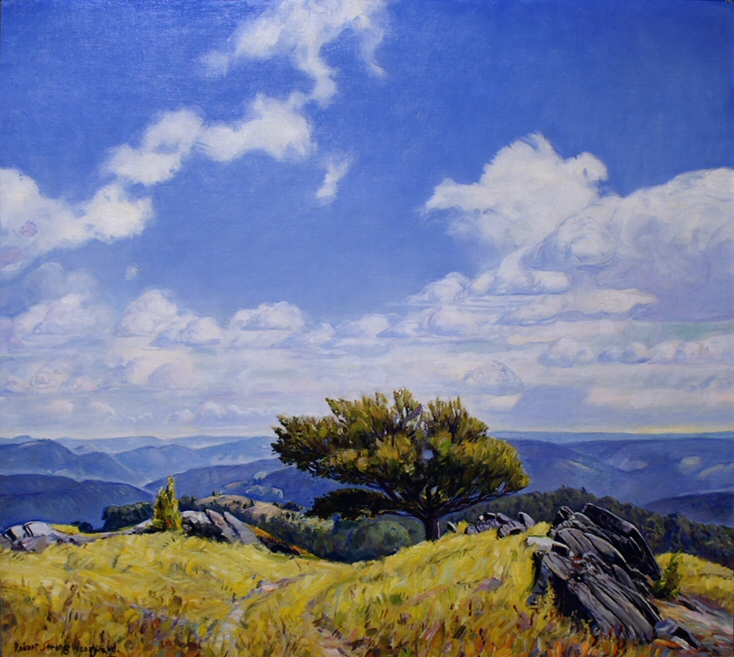Jack Benny

The Jack Benny Show radio regulars from left to right: Dennis Day, Don Wlson, Eddie "Rochester" Anderson, Benny, (wife) Mary Livingstone and Phil Harris
Comedian, radio and television personality Jack Benny is recognized as one of the 20th century's most prominent entertainers. He is also considered one of the most influential originators of the television sitcom. In 1938, Benny and his wife Mary Livingston built a new house in Beverly Hills, California and hired the popular interior designer, former Hollywood set designer and close Woodward friend Harold Grieve to furnish and decorate the new home. Grieve often exhibited Woodward's work in his Hollywood studio. From 1936 to 1939, Woodward sent 15 paintings to Grieve in California, one of which wasFrom a Hill Pasture.
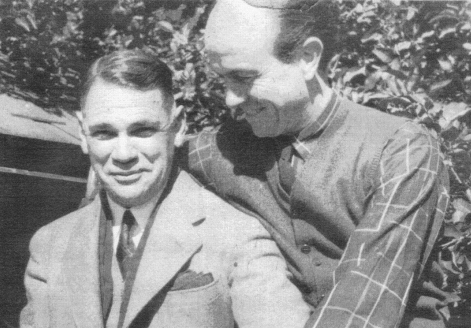
 RSW with close friend Harold Grieve
RSW with close friend Harold Grieve
From Woodward's dairy comments, it is believed RSW painted this painting in tones and hues to compliment the color schemes given him by Grieve. The painting would hang in the Benny living room when all was said and done. And like that of the painting purchased by the comedy duo and Benny friends, George Burns and Gracie Allen, found its way into a publication (seen below and to the left) but which we do not know. We imagine the picture, with its folds, was mailed to Woodward by Grieve sometime afterwards.
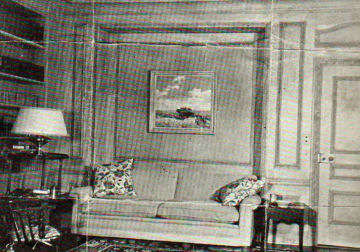
 A photograph of Jack Benny's living room at
A photograph of Jack Benny's living room at
1002 N. Roxbury Drive in Beverly Hills, CA.
Diary Comments regarding From a Hill Pasture:
"Painted in 1939. Again my Heath Pasture beech tree, made in blues and yellows to color scheme given me of the living room of Jack Benny and his wife Mary Livingstone, movie and radio stars, and bought by them for their new house (decorated by Harold Grieve) at 1002 N. Roxbury Drive, Beverly Hills, California."
We believe that there were also a number of other paintings placed by Mr. Grieve but the records, even letters between the two are missing or have been lost. It is known that probably about a dozen Woodward oils were hung in homes in the Hollywood area but to who remains a mystery.
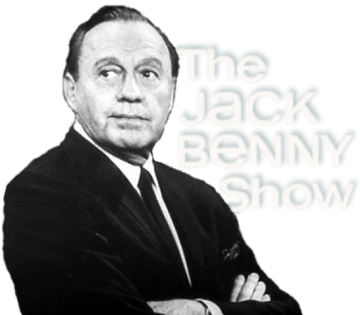
 Actor & Comedian Jack Benny
Actor & Comedian Jack Benny
Benny was born Benjamin Kubelsky in Chicago, IL on February 14, 1894, and grew up in nearby Waukegan, Illinois. Benny's parents wanted him to grow up to be a concert violinist and he began to take lessons at 6. His instructor was Otto Graham Sr., father of the great NFL star Otto Graham. Benny loved the violin but hated practicing. He played in bands and orchestras in high school but had a reputation of being a distracted dreamer making him a poor student. He would be eventually expelled from high school and later would flunk out of business school where he had hoped to join his father in business. Benny, famous for poking fun at himself, often used his life experience for laughs. In a March 21st, 1964 broadcast of his program, "The Jack Benny Show," his guest stars were the musical group, "The Lettermen." In the opening monologue of the show, he asked the group where their name originated and they explained that they all met in college, participated in sports and all had earned their "Lettermen's" jackets. After some banter about the extracurricular activities of college life, one of the group members ask Benny if he had the same experience, "while he was in college?" to which Benny, in his trademark manner, clasped his hands for a long pause and turns to his audience who is on to the inside joke. He admits, he did not go to college and another member of the group suggest that "surely you did extracurricular activities in high school? You did go to high school, right Mr. Benny?" to an even more awkward pause and laughter.
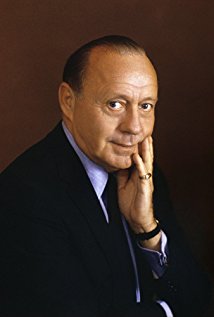
 Benny photographed portraying
Benny photographed portraying
his iconic arm across his body and
fingers to his cheek pose.
Benny's start in show business began when in 1911, he started playing violin in local vaudeville theaters for $7.50 a week. It is here he would meet the Marx Brothers and form a lasting friendship for life, especially Zeppo who was considered his closest friend. The brother's mother, Minnie, loved Benny's violin play and invited him to join them on the road as part of the act but his parents refused permission for their 17-year-old son to travel. Benny would continue to perform, often with a partner on piano. Five years later Benny would make it to the Palace Theater in NYC, considered the "Mecca of Vaudeville". It did not go well for him and he left showbiz briefly and enlisted in the Navy during World War I. He would perform for the troops and be often boo'd. A friend of Benny suggested he ab-lib some material to get himself out of tight spots to which he received good revues and earned a reputation as a comedian and musician. After the war, Benny continued to perform. After his second legal difficulty regarding the similarity of his name and another performer's, Benny adopted the generic sailor nickname "Jack" and was now officially Jack Benny for the remainder of his career.
It is believed that Benny's start in radio (CBS: 1932-1948 | NBC: 1949 - 1955) and later television (1950 -1965) was prompted by his appearance on Ed Sullivan's radio program in May of 1932. In the fall of the same year, Benny would have his own show that ran for more than three decades and is generally regarded as the highest rated show and a high-water mark in 20th-century American comedy. Benny's comic persona changed over the course of his career. However, he is most remembered for developing the persona of a miserly, petty, vain and self-congratulatory person who was a terrible violinist. Perfectly described on Wikipedia, "His comic rendering of these traits was the linchpin to the success of his show. Benny set himself up as the comedic foil, allowing his supporting characters to draw laughs at the expense of his own flaws. With his humanism and vulnerability in an era where few male characters were allowed such character traits, Benny made what could have been unlikable into an everyman character." However, Benny himself was none of these things, in fact, he was extremely generous and humble, particularly with his co-stars and fellow cast mates. Benny is noted as saying that he did not care who got the laughs so long as the show was funny.
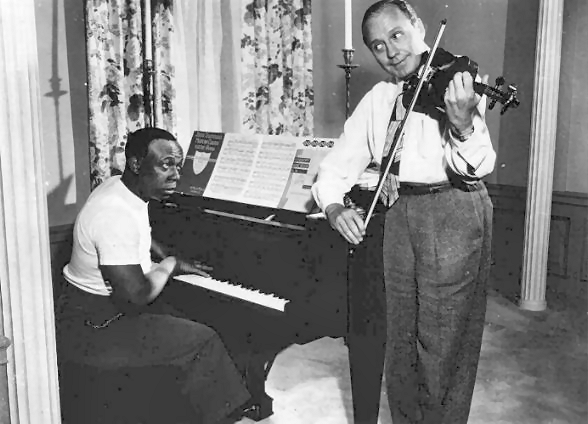
 Benny with Eddie "Rochester" Anderson
Benny with Eddie "Rochester" Anderson
The Jack Benny Show was also groundbreaking in the sense that, though it still held a hint of racial stereotype, his co-star Eddie Anderson, who played the butler-type character of Rochester was portrayed as every bit Benny's equal on the program. Benny was also famous for attracting stars not normally seen on the small screen of TV to appear on his show, such as, Rock Hudson, Marilyn Monroe, John Wayne, Tony Curtis, Vincent Price and possibly one of the best actresses of her time, Irene Dunn. He also made use of numerous voice actors from radio and cartoons, such as Mel Blanc of Bugs Bunny, Looney Tunes and Flintstones fame, to perform hilariously strange characters on his program. In probably every sense of the word, Benny was a revolutionary pioneer in the world of today's multi-media entertainment. He is often credited with developing what would become the 'situational comedy' or as it is called today, the sitcom. In fact, I would argue that Benny's program was the original show "about nothing" and an inspiration for comedian Jerry Seinfeld's show, Seinfeld. A program many consider being the greatest sitcom of ALL time.
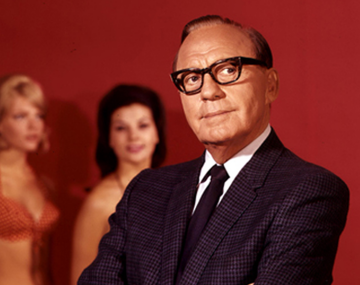
 A 1970's special appearance
A 1970's special appearance
Benny's legacy, even by today's standards, is unparalleled. He was and is still iconic. The program ended in 1965 when Benny decided to stop doing it while the ratings were still respectable. There is some indication that he did not like the demeanor or attitude of CBS President at the time, James T. Aubrey, and he left before being kicked out. None the less, Benny, who was so beloved and admired, would continue to make special appearances on other shows and programs (many of who were once guest on his show, such as, Carol Burnett) for the remainder of his life. I once heard a story told by motivational speaker Brian Tracy that according to Benny's biographer Jack made more money in his retirement making appearances then he did in his entire career. I find that so hard to believe, but then I consider how he often poked fun and balked at the price demands of his guest stars on his show. He would create entire skits on haggling over contracts and not having the need to deal with agents and whatnot... and it becomes a more believable possibility.
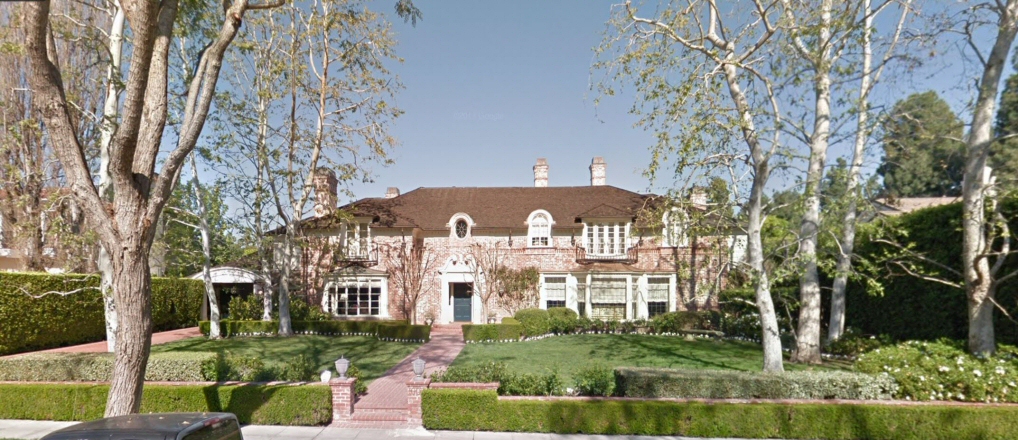
1002 N. Roxbury Drive today
Roxbury drive was THE neighborhood of the stars in its day. It is still beautiful today, the home recently sold in 2017 for 7.7 million dollars. In Benny's time, the Beverly Hills
neighbood featured the likes of Bette Grable, Jimmy Stewart and Ginger Rogers. Lucille Ball lived right next door to the Benny's for crying out loud. In 1944, Benny reportedly put on a New Year's Eve party
under tent in his backyard. The guest list was a who's who of classic Hollywood. For more on this neighborhood and the stars that lived in it, visit our source page by clicking this link:
Seeing-Stars.com
Editor's Note: Much of this terribly brief profile of Jack Benny was sourced from two Wikipedia pages devoted to Benny himself and The Jack Benny Show, as well as his IMDb page. We certainly could not do this legend justice in our much-abbreviated version. We strongly suggest you visit those pages listed for more on this extraordinary man and performer. The whereabouts of the painting today is unknown. Benny had only one child, a daughter, Joan, with whom he and his wife Mary Livingstone adopted. We would hope that she grew up loving the painting as many beneficiaries of Woodwards do and has kept it dear to her heart.


